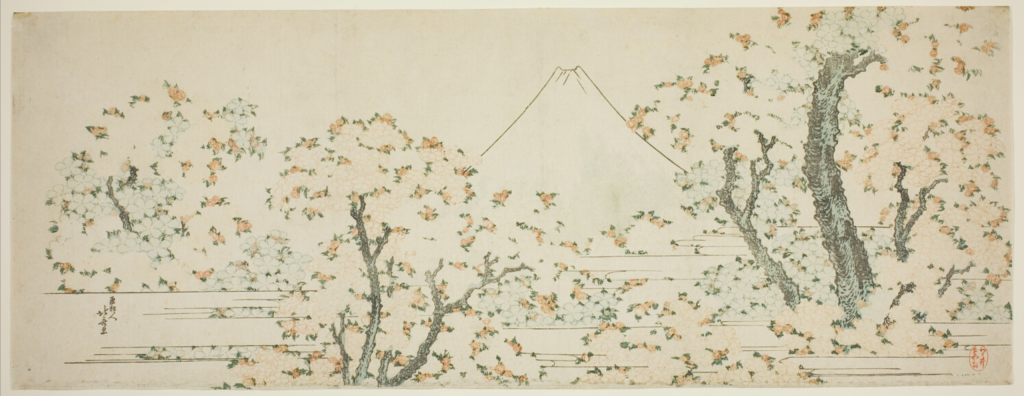Heaven, path to heaven, or home of some gods, the summit of the Mount Fuji has been thought of as sacred since ancient times and was forbidden to women until the Meiji era in the late 1860s.



Mount Fuji has been present in Japanese folklore since the 10th century, and has always been an inspiration in all forms of culture, from table ware motif to clothes pattern, from decorative prints for home to literature. In The Tales of Arise (Ise monogatari 伊勢物語) (Part N° 9, Heading Eastward), or in the illustrated biography of Prince Shotoku (Shōtoku taishi denryaku 聖徳太子伝暦), the Mount Fuji already appears as the closest path to heaven in its oldest appearance in classical literature enhanced with illustrations.
More recently in “A Miscellany of Old Letters” (c. 1690-91, published 1696), by Ihara Saikaku, (a choninmono style novel of the late Genroku period) where a former maid of a rich family mistook a kitchen bowl upside down for a porcelain model of the Mt. Fuji or more far back in time in “the Tale of the Bamboo Cutter”, the oldest extant fictional prose tale in Japanese literature, after Princess Kaguya [The Shining Princess] returned to the moon, it is said that the elixir and the letter of the princess were sent to burn on Mt. Fuji’s top by the emperor, this explaining why smoke is still rising from Mt. Fuji.

From an illustrative point of view, in the latter half of the Heian period, the story was adapted on various forms in Buddhist tales, and it continued to be widely enjoyed in illustrated vernacular tales (otogizōshi ) and picture scrolls (emaki). Also came many pictorial examples starting at the same period with drawings and paintings and prolongating until the Edo period with the most famous woodblock prints known today (mostly from Hiroshige and Hokusai). The modern era, with its mechanized duplication has now saturated the art market with hundreds of artworks, from saturated pictures for postcards, screen prints, offset posters, to all kind of home appliance gadgets, food and apparel brands, loosening its majesty. We personally try now to offer something connected to the glorious ancient fame of the Fuji-san.

We started our Japanese trilogy in 2019 with the idea of making it like an ikebana, one book for each of the three parts (known as Shin, Soe, Tai) used for the arrangement, which are symbolically earth, human and heaven, according to the ancestral rules of this art.

Our first piece WISPER OF THE SNOW, a wonderful collection from Juri Ishiwata’s photographs, was deeply connected to earth; the land, the countryside and the forest at the mercy of the weather.
Our second piece ONCE IN A CORNER took form in the hands of Kazuyuki Yamada with the metaphorical fair depiction of the fragility of the human, wounded by its perseverance to live and survive, and totally handmade by the artist as a proof of the human connection.
The last part of our Japanese trilogy is connected to the sacred with a depiction of the most famous national symbol of Japan : The Mount Fuji! But no tourism race in sight, the work of the artist is based on the everyday life. Just like in the first thirty-six views of Mount Fuji woodblock prints from Hokusai, the contemporary views offer a scene where the cars have replaced the horses, the tourists have taken the places of monks, merchants and pilgrims climbing the harsh tracks to redemption or wisdom, the drone are the new kites, and the electric poles replace the wood signs and trees of the villages. In Masuko’s photos, through the four seasons, the Mount is the guardian of the surroundings, sometimes showing up discreetly like a benevolent father, sometimes shot as the main character in a portrait style, but always bringing a impressive silent force to the composition.
The book 200 VIEWS OF MOUNT FUJI is a massive collection, allowing immersion in the modern Japan through the heritage of wood block printing masters and the view of a contemporary photographer. It gives back its place to the Japanese icon, the Mount Fuji is not treated as a pop idol but as the close friend or the reliable ancestor in every Japanese heart.

Leave a comment